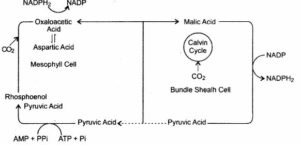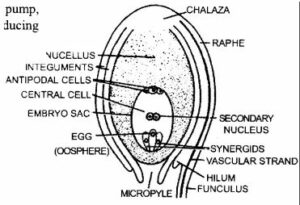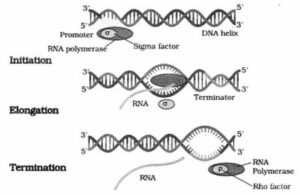ISC Biology 2017 Class-12 Previous Year Question Paper Solved for practice. Step by step Solutions with Part-I, and II (Section-A,B and C). By the practice of ISC Biology 2017 Class-12 Solved Previous Year Question Paper you can get the idea of solving.
Try Also other year except ISC Biology 2017 Class-12 Solved Question Paper of Previous Year for more practice. Because only ISC Biology 2017 Class-12 is not enough for complete preparation of next council exam. Visit official website CISCE for detail information about ISC Class-12 Biology.
ISC Biology 2017 Class-12 Previous Year Question Papers Solved
-: Select Your Topics :-
Maximum Marks: 70
Time allowed: Three hours
(Candidates are allowed additional 15 minutes for only reading the paper. They must NOT start writing during this time.)
- Answer all questions in Part I and six questions in Part II, choosing two questions from each of the three sections A, B and C.
- All working including rough work, should be done on the same sheet as, and adjacent to, the rest of the answer.
- The intended marks for questions or parts of questions are given in brackets [ ].
Part-I (20 Marks)
ISC Biology 2017 Class-12 Previous Year Question Papers Solved
Question 1.
(a) Give a brief answer for each of the following: [4]
(i) Why do Green plants start evolving CO2 instead of O2, at high temperatures?
(ii) Define Apomixis.
(iii) What is a Recon?
(iv) Why are the spores of Bacillus thuringiensis used as bioinsecticide?
(b) Each of the following question(s)/statement(s) has four suggested answers. Choose the correct option in each case. [4]
1. Initiation codon of protein synthesis in Eukaryotes is:
(i) GUA
(ii) GGA
(iii) CCA
(iv) AUG
2. Type of Interaction where an individual sacrifices its own welfare (life) for the benefit of another animal of its own species is:
(i) Altruism
(ii) Scavenging
(iii) Protocooperation
(iv) Commensalism
3. Wings of Insect and Birds are examples of:
(i) Analogous
(ii) Homologous
(iii) Vestigial
(iv) Atavism
4. The pressure of the cell contents on the cell wall is known as:
(i) Wall pressure
(ii) Osmotic pressure
(iii) Turgor pressure
(iv) Diffusion pressure
(c) Give a scientific term for each of the following: [4]
(i) An act of expelling the full term foetus from mother’s uterus at the end of gestation.
(ii) Entry of pollen tube into an ovule through integuments.
(iii) An alternative form of the single gene which influences the same character and produces different expressions in different individuals of.a species.
(iv) The study of human population covering all aspects and parameters.
(d) Expand the following abbreviations : [4]
(i) MTP
(ii) IW
(iii) HIV
(iv) DPD
(e) Name the scientists who have contributed to the following: [4]
(i) Discovered the fossil of Cro-Magnon man.
(ii) Classified active and passive absorption of water by roots.
(iii) Reported Haemophilia.
(iv) Discovered double fertilization.
Answer:
(a) (i) It is due to photorespiration. The green cells in the presence of light, take-up oxygen and produce CO2, without yielding any useable energy.
(ii) Apomixis is a type of asexual reproduction which mimics sexual reproductive i.e. production of seeds without pollination and fertilization.
(iii) Recon is the small segment of DNA which can undergo recombination.
(iv) Spores of Bacillus thuringiensis contain toxic cry proteins also called Bt-toxin which kill larvae of insects.
(b)
1. – (iv) AUG .
2. – (ii) Altruism
3. – (i) Analogous
4. – (iii) Turgor pressure
(c)
(i) Parturition
(ii) Mesogamy
(iii) Allele
(iv) Demography
(d)
(i) Medical Termination of Pregnancy
(ii) In-Vitro Fertilization
(iii) Human Immunodeficiency Virus
(iv) Diffusion Pressure Deficit.
(e)
(i) Edward Lartet (1868)
(ii) Kramer (1949)
(iii) John Otto (1803)
(iv) Nawaschin (1898)
Sections-A, Part- II,
ISC Biology 2017 Class-12 Previous Year Question Papers Solved
Question 2.
(a) Differentiate between Apes and Man with respect to the following characteristics:
(i) Posture
(ii) Brow ridges
(iii) Cranial capacity
(b) Define protobionts. [1]
(c) What is cognogeny? [1]
Answer:
(a)
(i) Semi-erect posture Completly erect posture
(ii) Brow ridge prominent Brow ridges weakly developed
(iii) Cranial capacity 100-500 cm3
(iv) Cranial capacity 1400-1450 cm3
(b) Protobionts have various types of chemicals like proteins, nucleic acids, carbohydrates, etc., enclosed inside a lipid membrane an<f proteins got associated with the membrane covering of protobionts.
(c) Cognogeny : It refers to the evolution of different life forms on this planet-the Earth.
Question 3.
(a) Explain any three molecular (genetic) evidences in favour of organic evolution. [3]
(b) Define biogenesis. [1]
(c) Define fossils. [1]
Answer:
(a)
(i) All organisms have cellular structure and DNA is the genetic material, indicating their common ancesting except RNA virus.
(ii) Genetic information flow from DNA to RNA to protein, a phenomenon called Central Dogma.
(iii) Mutations are the source of new variations and fountain head of evolution.
(iv) Genetic information is stored in the DNA in the form of sequence of nucleotides. Genetic code is a triplet code. It is same from bacteria to humans (any three points).
(b) The phenomenon of biogenesis states that living beings are neither produced spontaneously, nor created. Instead life comes from pre-existing life.
(c) Fossils are the remains, tracks, impressions or traces of organisms that existed in the past.
Question 4.
(a) List any three drawbacks of Darwinism. [3]
(b) State Hardy-Weinberg’s principle. [1]
(c) Differentiate between Directional natural selection and Disruptive natural selection. [1]
Answer:
(a) Drawbacks of Darwinism : .
(i) Though his theory is based on the presence of variations, he could not explain the origin of variation nor could he attach any importance to mutations.
(ii) Darwin could not explain the origin of new characters. It only provide mechanism of modification of already existing characters.
(iii) Over specialised organs are those which have grown beyond their maximum usefulness. They have become a hindrance for the animal, e.g., branched antlers of deer, tusk of elephant, etc.
(b) All the genes and their alleles found in an interbreeding population is called gene pool. Normally, the alleles tend to maintain an equilibrium with reference to one another oyer the generation irrespective of the phenotypic expression. It is called genetic equilibrium. A change in relative frequency of alleles brings about evolution.
(c) If the selection favours small or large sized individuals, more individuals of that type will be present in the next generation. With continued selection over generation mean size of the population would have changed it. It is directional selection which brings about evolution in the population. In the natural selection, both small size and long sized individuals, natural selection would be disruptive type. It produces two peaks in the distribution of trait that may lead to the development of two different population.
Sections-B, Part- II,
(Answer any two questions)
ISC Biology 2017 Class-12 Previous Year Question Papers Solved
Question 5.
(a) Give four anatomical differences between a dicot leaf and monocot leaf. [4]
(b) Briefly describe the secretory phase of the menstrual cycle. [4]
(c) Define: [2]
(i) Menarche
(ii) Actinomorphic symmetry
Answer:
(a)
| Dicot leaf | Monocot leaf |
| (i) Dorsiventral in orientation | (i) Vertically placed |
| (ii) Upperside darker green than lower | (ii) Both side are equally green |
| (iii) Stomata are more on lower or abaxial side | (iii) Stomata equally distributed on both sides |
| (iv) Stomata bounded by kidney guard cells | (iv) Stomata bounded by girdle-shaped guard cells |
| (v) Mesophyll differentiated into palisade and spongy parenchyma | (v) Mesophyll undifferentiated |
| (vi) Reticulate venation | (vi) Parallel venation |
(b) Secretory phase begins after ovulation. Corpus luteum the remnants of graafian follicle under influence of LH secretes hormones namely progestrone and estrogen. Both LH and progestrone help in further growth and thickening of endometrium and its gland become secretory endometriums fully ready for the attachment and nourishment of blastocyst. In case high presence of progestrone reduce level of LH and FSH which result in reduced synthesis of progestrone. Endometrium breakdown and moves out in the form of mucus and blood. Corpus luteum degenerate into white body called corpus albicans.
(c)
(i) Menarche : It is the stage when a girl menstruates for the first time.
(ii) Actinomorphic symmetry: When a regular flower can be divided into two equal halves through any plane.
Question 6.
(a) Give a graphic representation of the Hatch Slack or C4 cycle.
(b) Give two significant differences between:
(i) Transpiration and Guttation
(ii) Chlorophyll ‘a’ and Chlorophyll b ‘
(c) Define the following: [2]
(i) Amniocentesis
(ii) Polyembryony
Answer:

Graphic Representation of Hatch Slack Cycle
(b)
(i)
| Transpiration | Guttation |
| (i) Water loss in the form of vapour (ii) Occurs through stomata lenticel and cuticle (iii) Occurs through all aerial parts (iv) Dry conditions favour it |
(i) Water lost in the form of water droplets (ii) Occurs through hydathode (iii) Occurs at vein end on the margin/tip of leaves (iv) Occurs in humid condition, do not favour transpiration |
(ii)
| Chlorophyll ‘a’ | Chlorophyll ‘b’ |
| (i) Presence of methyl group (-CH3) at carbon atom 3 of pyrrolring 11. (ii) Chi. ‘a’ has molecular formula C55 H72 O5 N4 Mg (iii) Blue-green in colour (iv) Soluble in petroleum ether (v) Primary photosynthetic pigment |
(i) Instead of methyl group, there is present CHO group (ii) Chi ‘b’ has a molecular formula C55H70O6N4 Mg (iii) Yellow-green (iv) Soluble in methyl alcohol (v) Accessory pigment |
(any two points)
(c)
(i) Amniocentesis : It is a technique in which amniotic fluid is withdrawn from the uterus of a pregnant lady and the amniotic cells are cultured and studied for cytological observations to determine any chromosomal abnormalities.
(ii) Polyembryony : The phenomenon of presence of more than one normal embryo in a seed is called polyembryony. The extra embryos may be nucellar or integumental in origin. e.g., orange fruits.
Question 7.
(a) Describe K+ transport stomatal mechanism. [4]
(b) Draw a neat labelled diagram of L.S. of anatropous ovule. [4]
(c) Differentiate between the following : [2]
(i) Spermatogenesis and oogenesis
(ii) Apocarpous ovary and syncarpous ovary.
Answer:
(a) According to the theory the change in turgor pressure that open and close the stomata results from the reversible absorption and loss of potassium ions (K+). Light induced stomata opening is accompanied by transport of K+ from subsidiary cell to the guard cells. It is an energy-requiring process.
During day, starch produced change into malic acid which dissociates in malate anions and H+ in guard cell H+ is exchanged with K+ in subsidiary cells. It is active process. K+ ions and malate ions results in increase osmotic pressure and water moves into guard cells from surrounding cells. Increase in turgor, results in opening stomata.
During night, the reversal of K+ – K– pump, low osmotic pressure of guard cell, inducing closure of stomata through exosmosis.
(b) L.S. of Anatropous ovule.

STRUCTURE OF A TYPICAL. OVULE (ANATROPOUS OVULE)
(c)
(i) Spermatogenesis is a special type of reduction divison which occur in testes and result in the production of sperms. Oogenesis is a special type of reduction divison which occur in ovaries and result in the formation of ova/eggs.
(ii) When there are many free carpel in a flower-apocarpous. When two or more than two carpels are fused to form a single compound carpel- syncarpous.
Sections-C, Part- II,
ISC Biology 2017 Class-12 Previous Year Question Papers Solved
Question 8.
(a) Explain Pleiotropy with reference to phenylketonuria.
(b) Explain the mechanism of transcription in a prokaryotic cell.
(c) Explain Rh factor incompatibility during pregnancy.
Answer:
(a) Pleiotropy involves the ability of a gene to have multiple phenotypic effects, because it influences a number of characters simultaneously. The genes are called pleiotropic genes.
Example :
A mutated recessive gene for the disorder phenylketonuria produces multiple phenotypic expressions -mental retardation and reduction in hair and skin pigmentation. Phenylketonuria is due to autosomal recessive trait. It lacks an enzyme to convert phenylalanine to tyrosine. Phenylalanine accumulates in the body. Accumulation in brain results in mental retardation.
(b) Transcription is the process of copying genetic information from sense strand of DNA into RNA, only a segment of DNA is transcribed that only one of the two strands is copied. In prokaryotes, transcription occurs in contact with cytoplasm as their DNA lies in cytoplasm. Transcription requires a DNA dependent enzyme RNA polymerase. Prokaryotes have only one RNA polymerase which synthesises all types of RNAs. The transcription includes following steps :
- Activation of nucleotides in the nucleoplasm through phosphorylation. These are ATP, GTP, UTP and CTP.
- A single RNA – polymerase binds to the promoter site/region of DNA template. Chain opening of DNA segment by uncoiling occurs from the site of polymerase binding.
- Initiation of transcription occures by the complementary pairing of free activated ribonucleotides with the nitrogen bases of DNA template.
- Activated ribonucleotide triphosphate acts as substrate and also provides energy for polymerisation on a template following the rule of complementarity.
- As the RNA chain formation initiates, the sigma(cr) factor of RNA polymerase separates. RNA polymerase moves along the coding region of DNA template causing elongation of RNA chain.
- RNA synthesis stops as soon as the polymerase reaches the terminator region. Rho(p) factor is required for this. Terminator region has a stop signal.
- Rho factor helps the release of nascent RNA, RNA polymerase falls off. It is the termination of transcription.

- In prokaryotes, the /n-RNA synthesis does not require any processing to become active and both transcription and translation occur in the same cytosol.
- Translation can start much before the m-RNA is fully transcribed, i. e., transcription and translation can be coupled.
(c) The human beings who have antigen on RBCs are Rh+ while others who do not have are Rh. It is through Rh+ is dominated over Rh- which is recessive.
In a marriage between Rh– woman and Rh+ man, when a woman become pregnant, she becomes sensitive while carrying a first Rh+ child within her womb. It is because some of RBCs from the developing embryo get into the blood stream of mother during development causing her to produce anti-Rh-antibodies. The first child of such parents is normal and is delivered safely. However, if such a mother get pregnant again the resulting Rh+ foetuses will be exposed to anti-Rh-bodies produced by the mother.
As a result serious damage to RBCs of the developing embryo will occur causing erythroblastosis foetilis. The disease leads to the death of the developing embryo before birth or after parturition.
Question 9.
(a) Discuss the various In-situ and Ex-situ strategies for conservation of biodiversity. [4]
(b) List any four applications of tissue culture. [4]
(c) Mention the causative agent and the preventive measures for each of the following: [2]
(i) Gonorrhoea
(ii) Pneumonia.
Answer:
(a) In-situ conservation is on-site conservation. It is carried out by
(i) Sacred groves
(ii) Sacred lakes
(iii) Protected areas-India has 89 National Parks, 492 Wildlife Sanctuaries and 13 Biosphere Reserves. The Protected Areas include terrestrial areas, wetlands and aquatic ecosystem.
National Afforestation Ecodevelopment Board (NAEB) looks after afforestation,
(i) tree planting, ecological restoration and ecodevelopment of the country,
(ii) Ex-situ conservation is also called off-site conservation. It is carried out by :
(a) Botanical and zoological garden
(ii) Gene Banks- Seed gene banks and Field gene banks are maintaining germplasm of different plants and animals. Wildlife Safari Parks
(iii) Cryopreservation techniques to preserve eggs of threatened species,
(iv) Tissue culture technique for propagation of plants.
(b) Applications of tissue culture :
(i) Rapid clonal propagation – an explant is used to produce numerous plants of same genotype,
(ii) From somaclonal variation, a number of useful varieties have been produced, e.g., Higher shelf life tomato,
(iii) Virus free plants by using meristem culture,
(iv) Embryo which normally do not survive inside the seeds can be grown in tissue culture. Embryo rescue useful in interspecific hybridisation.
(c)
(i) Gonorrhoea : It is a STD caused by Diplococcus bacterium Neisseriagonorrhoeal. It is transmitted by sexual intimacy. It is prevented by :
- avoiding sex with unknown partners,
- Use condom during coitus
- Consult qualified doctor for early detection and complete treatment.
(ii) Pneumonia : It is caused by Streptococcus or Diplococcus pneumoniae or Haemophilus influenzae. Disease is transmitted by droplet infections. The disease can be prevented by covering the mouth to prevent inhaling of droplets/aerosols when visiting an infected person, articles used by the patient should be properly sterlized. Proper disposal of the sputum of an infected person.
Question 10.
(a) Name the components of lac operon and discuss their role.
(b) Give the significance of transgenic animals.
(c) Give one significant difference between :
(i) Electroporation and Gene Gun.
(ii) ECG and EEG
Answer:
(a) The various components of lac operon are regulator gene, promoter gene, operator gene and structural genes. Regulatory genes synthesise a chemical called repressor which combine with operator gene to switch off the operon. In the presence of inducer – the lactose, repressor binds with lactose to free the operator gene and the operon is switch on. Promoter gene is the recognition site for RNA polymerase when the operon is switched on. The RNA polymerase pass over the operator gene and reach structural genes to transcribe them. Operator gene controls the expression of operon by switching on and off the structural genes transcribe polycistronic zn-RNA. Lac operon has three structural genes Z, Y and A. The polycistronic m-RNA produces three enzymes galactosidase permease (early of lactose into bacterium), β-galactosidase (breakage of lactose into glucose and galactosidase) and galactoside acetylase (transfer acetyl group to β-galactosidase).
Note : Inducer is a chemical generally a substrate binds with repressor to free the operator ‘ gene.
(b) Transgenic animals have great importance as
(i) to study the normal physiology and development, working of genes, their regulation etc.
(ii) study of diseases susceptibility to different diseases has been found to the genetically controlled, transgenic animals can be used to study how genes take part in the development of diseases,
(iii) By inserting genes for some important biological products specially milch animals, transgenic animals can be used for molecular farming or molecular harvesting, e.g., Protein a-1 anti trypsin for treating emphysema, lactoferrin (cow),
(iv) Vaccine safety testing on transgenic animals before marketing,
(v) Chemical safety testing,
(vi) Transgenic cattle with extra gene for growth hormone and caesin gives very high yield of milk. Transgenic cow Rosie yielded milk with high protein having human alpha lactalbumin a highly nutritionally balanced diet for human babies.
(c)
(i) Electroporation : A method for increasing DNA uptake by protoplast through prior exposure to high voltage which results in the temporary formation of small pore in cell membrane.
Gene Gun : It is the vectorless transfer of gene where tungsten or gold particles coating with desired genes are bombarded into the cells with great force. ,
(ii) ECG (Electrocardiograph): Gives vital information about
- rate and rhythm of heart beat
- condition of heart muscle.
(iii) EEG (Electroencephalograph): Represents spontaneous electrical activity of brain. The shape of the waves varies considerably depending upon the degree of activities with in the brain itself.
Or
It is a device used for recording the generation and transmission of electrical impulses through the conductive tissue of heart muscles.
-: End of ISC Biology 2017 Class-12 Solved Previous Year Question Paper :-
Return to – ISC Class-12 Solved Previous Year Question Paper
Thanks
Please Share with Your Friends.


